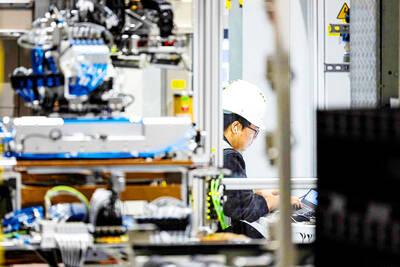Despite a strengthening local currency, Taiwanese exports rose to US$24.19 billion last month, up 8 percent from a month earlier, with shipments of electronics products hitting an all-time high of US$7.25 billion, the Ministry of Finance said yesterday.
“The foreign exchange rate only fluctuated sharply recently. The New Taiwan dollar averaged between NT$31 and NT$32 against the US dollar over the past few months,” Lin Lee-jen (林麗貞), head of the ministry’s statistics department, told a media briefing.
“It is really hard to tell whether the appreciation of the NT dollar impacted exports. Our trade rivals also saw currency gains. We need to observe it for a longer time,” Lin said.
On a yearly basis, exports posted better-than-expected growth of 21.9 percent, higher than the 17.5 percent gain in September, thanks to a pickup in sales to the US and Europe and a rebound in shipments of electronic products.
“The stronger readings in exports for last month should be taken as a positive sign that local exporters may have started to make delivery of orders ahead of the year-end festive season,” Standard Chartered chief economist Tony Phoo (符銘財) said yesterday in an e-mailed statement.
Exports to Europe were US$2.68 billion last month, posting the highest level since the global financial crisis. That represented an increase of 17.5 percent from a year earlier, the ministry said.
“Overseas buyers may not be as concerned as initially feared in terms of performance of year-end sales,” Phoo said.
In the first 10 months, exports reached a record high of US$226.4 billion, up 38.4 percent from a year earlier, with exports to China (including Hong Kong), six ASEAN nations and Japan all hitting the highest amount in history.
“This indicates that exports for the full year will likely post a record high,” Lin said.
However, she warned that a slower global recovery, combined with European austerity measures and potential foreign exchange rate fluctuations, could result in declines in fourth-quarter data.
Meanwhile, imports last month rose 2.8 percent to US$21.21 billion from US$20.63 billion in September as a result of growing purchases of consumer goods, which rose 16.4 percent sequentially.
On an annual basis, imports increased 27.9 percent, higher than 25 percent growth in September.
From January to last month, imports totaled US$33.5 billion, up 67.6 percent from a year earlier, due chiefly to substantial growth in the import of machinery, which rose US$10.12 billion or 90.2 percent year-on-year, the ministry’s data showed.
“All these figures reflect a rebounding confidence among local producers, firms and businesses, amidst an ongoing revival in domestic spending,” Phoo said.
Phoo said that last month’s data, coupled with the latest reading on inflation, suggested the possibility of another 12.5 basis points hike in interest rates by the central bank at its quarterly meeting next month.

CHIP RACE: Three years of overbroad export controls drove foreign competitors to pursue their own AI chips, and ‘cost US taxpayers billions of dollars,’ Nvidia said China has figured out the US strategy for allowing it to buy Nvidia Corp’s H200s and is rejecting the artificial intelligence (AI) chip in favor of domestically developed semiconductors, White House AI adviser David Sacks said, citing news reports. US President Donald Trump on Monday said that he would allow shipments of Nvidia’s H200 chips to China, part of an administration effort backed by Sacks to challenge Chinese tech champions such as Huawei Technologies Co (華為) by bringing US competition to their home market. On Friday, Sacks signaled that he was uncertain about whether that approach would work. “They’re rejecting our chips,” Sacks

It is challenging to build infrastructure in much of Europe. Constrained budgets and polarized politics tend to undermine long-term projects, forcing officials to react to emergencies rather than plan for the future. Not in Austria. Today, the country is to officially open its Koralmbahn tunnel, the 5.9 billion euro (US$6.9 billion) centerpiece of a groundbreaking new railway that will eventually run from Poland’s Baltic coast to the Adriatic Sea, transforming travel within Austria and positioning the Alpine nation at the forefront of logistics in Europe. “It is Austria’s biggest socio-economic experiment in over a century,” said Eric Kirschner, an economist at Graz-based Joanneum

BUBBLE? Only a handful of companies are seeing rapid revenue growth and higher valuations, and it is not enough to call the AI trend a transformation, an analyst said Artificial intelligence (AI) is entering a more challenging phase next year as companies move beyond experimentation and begin demanding clear financial returns from a technology that has delivered big gains to only a small group of early adopters, PricewaterhouseCoopers (PwC) Taiwan said yesterday. Most organizations have been able to justify AI investments through cost recovery or modest efficiency gains, but few have achieved meaningful revenue growth or long-term competitive advantage, the consultancy said in its 2026 AI Business Predictions report. This growing performance gap is forcing executives to reconsider how AI is deployed across their organizations, it said. “Many companies

France is developing domestic production of electric vehicle (EV) batteries with an eye on industrial independence, but Asian experts are proving key in launching operations. In the Verkor factory outside the northern city of Dunkirk, which was inaugurated on Thursday, foreign specialists, notably from South Korea and Malaysia, are training the local staff. Verkor is the third battery gigafactory to open in northern France in a region that has become known as “Battery Valley.” At the Automotive Energy Supply Corp (AESC) factory near the city of Douai, where production has been under way for several months, Chinese engineers and technicians supervise French recruits. “They